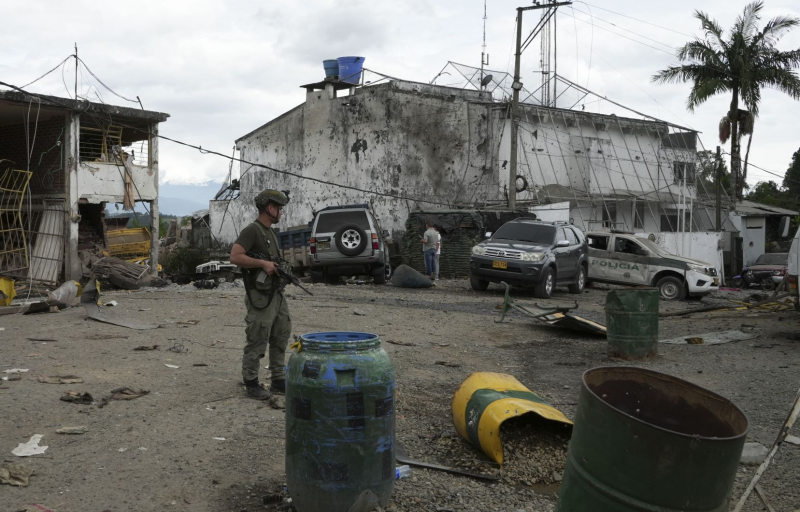
Photo: Juan B Diaz Associated Press A police officer stands guard at a police station after an attack in Morales, Colombia, Monday, May 20, 2024. Police say two officers died in the attack by dissidents of the Revolutionary Armed Forces of Colombia (FARC), known as EMC.
Stéphane Blais – The Canadian Press
Published at 10:16
- Amériques
Canadians travelling to Colombia in the coming days to attend the COP16 biodiversity conference are being urged to exercise a high degree of caution, as guerrillas have threatened to wreak “mayhem” at the event.
Colombian authorities have deployed a massive security presence to welcome 12,000 participants to the UN biodiversity conference in the city of Cali.
More than 4,000 additional police officers have joined the city’s 6,000 regular officers, and they will be supported by 1,600 soldiers from the Colombian National Army.
“This deployment is important and at the same time, it is very revealing of the fragility and instability of security in this region of Colombia,” said researcher Eduardo Álvarez-Vanegas, in an interview with The Canadian Press.
Clashes between Colombian authorities and some armed groups have intensified in recent weeks.
For example, on October 16, the Colombian Defense Ministry announced that it had dealt “a severe blow to Iván Mordisco’s dissidents” by killing eight fighters from the group. of guerrillas in the Amazonian department of Caqueta.
Iván Mordisco is the main leader of the dissident Revolutionary Armed Forces of Colombia (FARC).
He is the head of the Central General Staff (EMC), a group that, according to Colombian media reports, recently threatened to derail COP16 and warned “delegates from the national and international community to refrain from attending” the event, promising that it would be a “fiasco.”
According to Eduardo Álvarez-Vanegas, a researcher at the Center for the Comparative Study of Civil War at the University of York in the United Kingdom, these fighters “want to take political advantage of such an important event to show the world that they exist.”
M. Álvarez-Vanegas worked at a research center that advised the Colombian government during the negotiation process that led to the peace agreement with the FARC in 2016.
200% Deposit Bonus up to €3,000 180% First Deposit Bonus up to $20,000According to him, Iván Mordisco's dissident group has proven in the past that it “can carry out small military actions that require simple logistics” and “little manpower”, but that can “cause a lot of damage through terrorist attacks”.
But does this group have the capacity to threaten the security of COP16 in Cali? ?
“Maybe they could do it by subcontracting or activating sleeper cells in the city. I'm not sure, but I think they will definitely try to commit military actions on the outskirts of Cali. »
Groups like the Central General Staff usually target authorities in rural areas, rather than in urban centers like Cali.
“Like in Jamundi, a municipality 30 kilometers from Cali where the group recently committed a major terrorist act,” the researcher pointed out.
The father of Vice President Francia Marquez and other members of his family recently survived an armed attack in this small town located south of Cali, in the department of Valle del Cauca.
Valle del Cauca is to be avoided
Federal Environment Minister Steven Guilbeault is scheduled to participate in the biodiversity summit, as are members of several Canadian organizations.
Travel advice published by Global Affairs Canada recommends avoiding “all non-essential travel” to certain departments of Colombia due to “activities drug-related crimes committed by illegal armed groups and other criminal organizations.”
The Valle del Cauca is to be avoided, according to the government, with the exception of certain cities, including Cali.
“In Colombia, the strength of the state is quite strong within the cities. But state control is still less pronounced in rural areas. This is one of the reasons why these armed groups are able to settle in these regions,” summarized Stockholm University researcher Simon Pierre Boulanger Martel, whose research focuses in particular on the Revolutionary Armed Forces of Colombia (FARC).
Dissidents who refuse to lay down their arms
The FARC signed a peace agreement with Colombia in 2016 after decades of armed conflict.
But dissidents refused the terms of the agreement to form the EMC.
“Then this group expanded to look for other structures elsewhere in Colombia and it became an umbrella organization of different groups that decided to continue the armed struggle,” explained Simon Pierre Boulanger Martel.
He added that some of the organizations that formed the EMC “depend on the structures of the illicit economy, like coca.”
The EMC has repeatedly announced that it will not “disarm” until it sees structural changes in Colombian society, explained Eduardo Álvarez-Vanegas.
“In their rhetoric, ending poverty, changing the economic model and stopping US military aid are the structural changes that Colombian society must make to end the armed struggle,” said researcher Álvarez-Vanegas.
In a press release issued at the beginning of October, Colombian Defense Minister Iván Velásquez stated that “thanks to the important work done by the police and military forces, the security of COP16 is guaranteed.”
According to the same press release, more than 100 ministers and 12 heads of state will participate in the summit, which takes place from October 21 to November 1.

